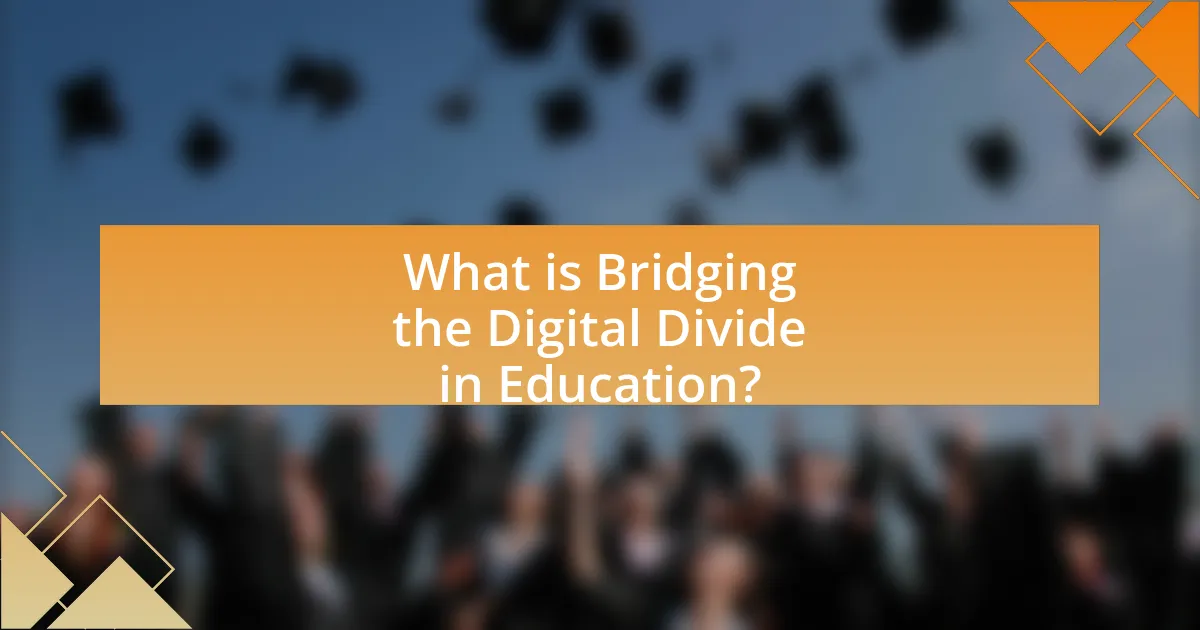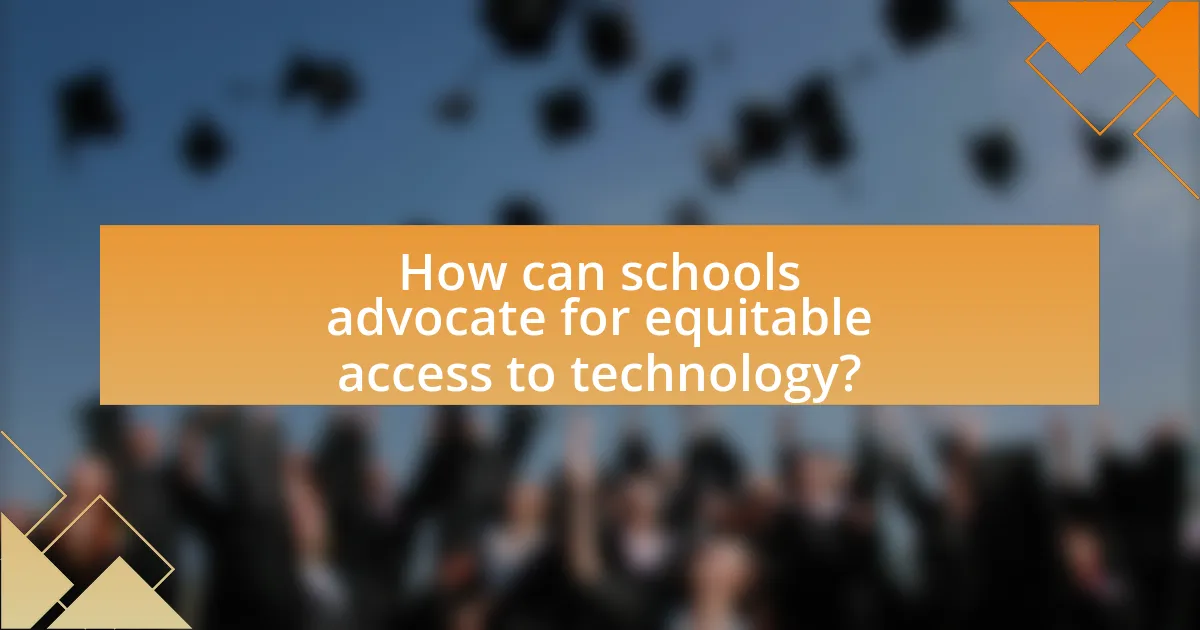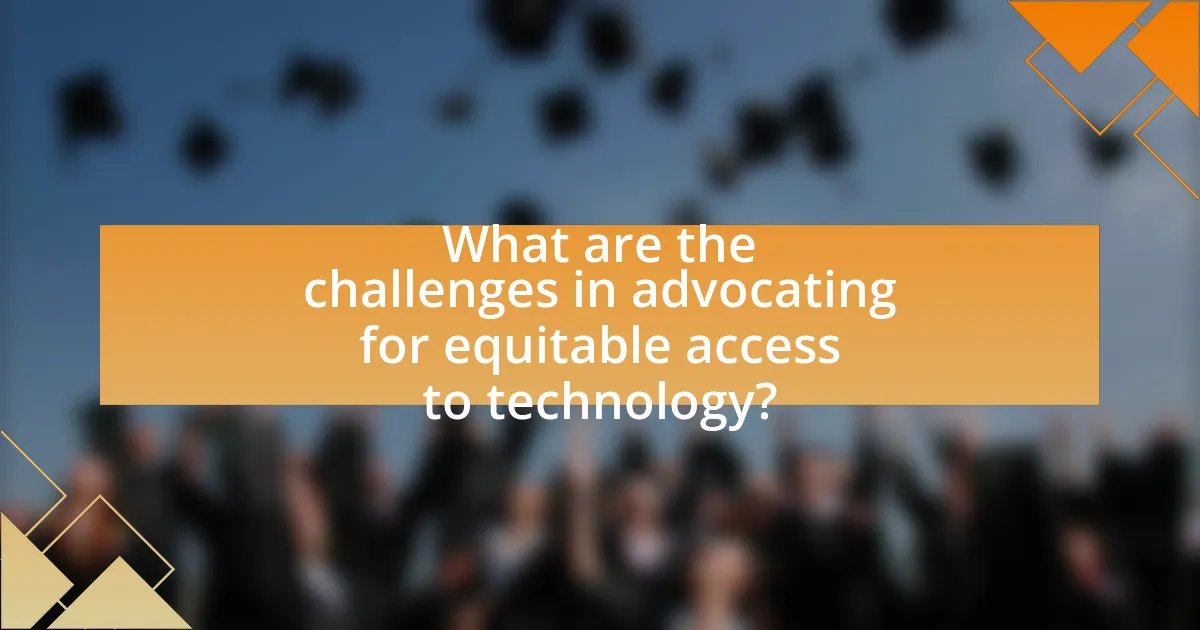Bridging the Digital Divide in Education refers to initiatives aimed at providing equitable access to technology and digital resources for all students, regardless of socioeconomic status. The article explores the importance of technology access in schools, the impact of unequal access on educational outcomes, and the key components contributing to the digital divide, such as socioeconomic factors and digital literacy. It also discusses existing initiatives and government policies designed to enhance technology access, the role of non-profit organizations, and strategies schools can implement to advocate for and improve technology access. Additionally, the article addresses the challenges faced in these efforts, including budget constraints and stakeholder resistance, while highlighting best practices for creating inclusive technology policies and ensuring sustainable access.

What is Bridging the Digital Divide in Education?
Bridging the Digital Divide in Education refers to efforts aimed at ensuring equitable access to technology and digital resources for all students, regardless of their socioeconomic status. This initiative addresses disparities in access to devices, internet connectivity, and digital literacy skills, which can hinder educational opportunities. For instance, a report by the Pew Research Center indicates that 15% of U.S. households with school-age children lack high-speed internet access, highlighting the need for targeted interventions to provide necessary resources. By implementing programs that provide devices and internet access, schools can foster an inclusive learning environment that supports all students in achieving academic success.
Why is equitable access to technology important in schools?
Equitable access to technology in schools is crucial because it ensures that all students, regardless of their socioeconomic status, have the same opportunities to succeed academically. When technology is accessible to every student, it facilitates personalized learning, enhances engagement, and prepares them for a technology-driven workforce. Research indicates that students with access to technology perform better academically; for instance, a study by the Pew Research Center found that 87% of teachers believe that technology positively impacts student learning. Furthermore, equitable access helps to close the achievement gap, as students from disadvantaged backgrounds often lack the resources to engage with digital tools outside of school.
How does technology impact student learning outcomes?
Technology significantly enhances student learning outcomes by providing access to diverse educational resources and personalized learning experiences. Research indicates that students who utilize technology in their learning process demonstrate improved engagement, higher retention rates, and better academic performance. For instance, a study published in the “Journal of Educational Psychology” found that students using digital tools scored 20% higher on assessments compared to those relying solely on traditional methods. This improvement is attributed to technology’s ability to cater to different learning styles and facilitate collaborative learning environments.
What are the consequences of unequal access to technology?
Unequal access to technology leads to significant disparities in educational outcomes and economic opportunities. Students without adequate technology access face challenges in completing assignments, participating in online learning, and developing essential digital skills, which can hinder their academic performance and future job prospects. According to a report by the Pew Research Center, 35% of lower-income households with school-age children lack high-speed internet access, limiting their ability to engage in remote learning effectively. This digital divide exacerbates existing inequalities, as those with limited access are less likely to pursue higher education and more likely to experience long-term economic disadvantages.
What are the key components of the digital divide?
The key components of the digital divide include access to technology, digital literacy, and socioeconomic factors. Access to technology refers to the availability of devices and internet connectivity, which varies significantly across different regions and demographics. Digital literacy encompasses the skills required to effectively use technology, which is often lacking in underserved communities. Socioeconomic factors, such as income level and education, further exacerbate the divide, as individuals from lower-income backgrounds may have limited opportunities to acquire both technology and the necessary skills to utilize it. These components collectively contribute to disparities in technology access and usage, impacting educational and economic opportunities.
What factors contribute to the digital divide in education?
The digital divide in education is primarily influenced by socioeconomic status, access to technology, and digital literacy. Socioeconomic status affects a family’s ability to afford devices and internet connectivity, leading to disparities in access. For instance, a report by the Pew Research Center indicates that 35% of lower-income households with school-age children lack high-speed internet, compared to only 5% of higher-income households. Access to technology is further compounded by geographic location, where rural areas often experience limited infrastructure. Additionally, digital literacy varies significantly among students and educators, impacting their ability to effectively utilize available technology. According to a study by the International Society for Technology in Education, only 30% of teachers feel adequately prepared to integrate technology into their teaching, highlighting the need for professional development. These factors collectively contribute to the ongoing digital divide in education.
How do socioeconomic status and geography influence access to technology?
Socioeconomic status and geography significantly influence access to technology by creating disparities in resources and infrastructure. Individuals from higher socioeconomic backgrounds typically have greater financial means to afford devices and internet services, while those from lower socioeconomic backgrounds often face barriers such as limited income and lack of access to high-speed internet. For example, a report by the Pew Research Center in 2021 indicated that 35% of lower-income households in the U.S. lacked broadband internet access, compared to only 5% of higher-income households. Additionally, geographic factors play a crucial role; rural areas often experience inadequate technological infrastructure, leading to limited access compared to urban regions where technology is more readily available. This combination of socioeconomic and geographic disparities contributes to the digital divide, impacting educational opportunities and overall access to information and resources.
What initiatives exist to bridge the digital divide?
Numerous initiatives exist to bridge the digital divide, focusing on providing equitable access to technology in schools. Programs such as the Federal Communications Commission’s E-Rate program help schools and libraries obtain affordable internet access, while organizations like EveryoneOn work to connect low-income families to the internet and digital literacy resources. Additionally, the Digital Equity Act aims to promote digital equity by funding projects that enhance broadband access and digital skills training. These initiatives collectively address the disparities in technology access, ensuring that underserved communities can benefit from digital resources essential for education and economic opportunities.
How do government policies address technology access in schools?
Government policies address technology access in schools by implementing funding initiatives, establishing regulations, and promoting partnerships that enhance digital resources. For instance, the E-Rate program in the United States provides discounts to schools and libraries for telecommunications and internet access, significantly increasing connectivity in underserved areas. Additionally, policies like the Every Student Succeeds Act (ESSA) encourage states to allocate resources for technology integration in education, ensuring that all students have access to necessary digital tools. These measures collectively aim to reduce disparities in technology access, thereby supporting equitable educational opportunities.
What role do non-profit organizations play in providing technology resources?
Non-profit organizations play a crucial role in providing technology resources by facilitating access to digital tools and training for underserved communities. These organizations often partner with schools and local governments to distribute devices, such as laptops and tablets, and offer programs that enhance digital literacy. For instance, organizations like EveryoneOn and TechSoup have successfully connected millions of individuals to affordable internet services and technology training, thereby addressing the digital divide. Their efforts are supported by data indicating that access to technology significantly improves educational outcomes, particularly in low-income areas, where students often lack essential resources.

How can schools advocate for equitable access to technology?
Schools can advocate for equitable access to technology by implementing targeted initiatives that address the specific needs of underserved communities. These initiatives may include establishing partnerships with local businesses and organizations to secure funding for technology resources, providing training for teachers and students on digital literacy, and creating programs that distribute devices and internet access to students in need. For instance, a study by the Pew Research Center found that 35% of lower-income households with school-age children lack high-speed internet access, highlighting the urgency for schools to take action. By actively engaging with stakeholders and leveraging community resources, schools can effectively promote equitable access to technology for all students.
What strategies can schools implement to improve technology access?
Schools can implement strategies such as increasing funding for technology resources, establishing partnerships with tech companies, and providing training for teachers to improve technology access. Increased funding allows schools to purchase devices and infrastructure necessary for digital learning, as evidenced by the fact that schools with dedicated technology budgets report higher student engagement in tech-based learning. Partnerships with tech companies can facilitate donations of devices and software, as seen in initiatives like Google’s “Chromebook for Education,” which has provided thousands of devices to underserved schools. Additionally, training teachers in technology integration ensures that they can effectively utilize available resources, leading to improved student outcomes, as research indicates that teacher proficiency in technology correlates with student success in digital environments.
How can partnerships with tech companies enhance resources?
Partnerships with tech companies can enhance resources by providing schools with access to advanced technology, training, and support. These collaborations often result in the donation of hardware, software, and educational tools that improve learning environments. For instance, initiatives like Google’s “G Suite for Education” offer free tools that facilitate collaboration and communication among students and teachers. Additionally, tech companies frequently provide professional development for educators, ensuring they are equipped to effectively integrate technology into their teaching practices. This combination of resources and training not only enriches the educational experience but also helps bridge the digital divide by making technology more accessible to underserved schools.
What funding opportunities are available for technology initiatives?
Funding opportunities for technology initiatives include federal grants, state programs, private foundations, and corporate sponsorships. For instance, the E-Rate program provides discounts to schools and libraries for telecommunications and internet services, while the Technology and Media Services for Individuals with Disabilities program offers grants to improve technology access for students with disabilities. Additionally, organizations like the Bill & Melinda Gates Foundation and the Chan Zuckerberg Initiative fund projects aimed at enhancing educational technology. These funding sources are crucial for bridging the digital divide and ensuring equitable access to technology in schools.
How can community involvement support technology access in schools?
Community involvement can significantly enhance technology access in schools by fostering partnerships that provide resources, funding, and expertise. Local businesses and organizations can donate equipment, such as computers and internet access, which directly addresses the technological needs of students. For instance, initiatives like the “Computers for Schools” program have successfully supplied thousands of refurbished computers to underfunded schools through community donations. Additionally, community members can volunteer their time to teach digital literacy skills, ensuring that students not only have access to technology but also the knowledge to use it effectively. This collaborative approach not only improves technology access but also strengthens community ties and promotes a culture of support for education.
What role do parents and local organizations play in advocacy?
Parents and local organizations play a crucial role in advocacy by mobilizing community support and influencing policy decisions related to equitable access to technology in schools. Parents often serve as primary advocates for their children’s educational needs, voicing concerns about disparities in technology access and pushing for necessary resources. Local organizations, such as non-profits and community groups, provide platforms for collaboration, raise awareness about the digital divide, and facilitate initiatives that promote equitable technology access. For instance, studies show that community-led advocacy efforts can lead to increased funding for technology programs in under-resourced schools, demonstrating the effectiveness of collective action in addressing educational inequities.
How can awareness campaigns raise support for technology access?
Awareness campaigns can raise support for technology access by educating the public about the importance of equitable technology distribution in schools. These campaigns highlight the disparities in access to technology, emphasizing that students without adequate resources face significant barriers to learning and future opportunities. For instance, a report by the Pew Research Center indicates that 15% of U.S. households with school-age children do not have high-speed internet access, which directly impacts students’ ability to complete assignments and engage in remote learning. By showcasing these statistics and personal stories, awareness campaigns can mobilize community support, influence policymakers, and attract funding to bridge the digital divide.

What are the challenges in advocating for equitable access to technology?
Advocating for equitable access to technology faces several challenges, including socioeconomic disparities, infrastructure limitations, and policy barriers. Socioeconomic disparities create unequal access to devices and internet connectivity, with low-income families often unable to afford necessary technology. Infrastructure limitations, particularly in rural and underserved urban areas, hinder reliable internet access, affecting students’ ability to engage with digital learning resources. Additionally, policy barriers, such as insufficient funding for technology initiatives in schools and lack of comprehensive digital equity strategies, further complicate efforts to ensure all students have equal access to technology. These challenges collectively impede the goal of bridging the digital divide in education.
What barriers do schools face in implementing technology initiatives?
Schools face several barriers in implementing technology initiatives, including insufficient funding, lack of infrastructure, and inadequate training for educators. Insufficient funding limits the ability to purchase necessary devices and software, as evidenced by a report from the National Center for Education Statistics, which found that 40% of schools reported inadequate funding for technology. Lack of infrastructure, such as unreliable internet access, further complicates implementation, particularly in rural areas where connectivity can be poor. Additionally, inadequate training for educators hinders effective technology integration; a study by the International Society for Technology in Education indicated that 60% of teachers felt unprepared to use technology in their classrooms. These barriers collectively impede the successful adoption of technology initiatives in schools.
How do budget constraints affect technology access?
Budget constraints significantly limit technology access by restricting the financial resources available for purchasing devices, software, and infrastructure. Schools with tight budgets often cannot afford essential technology, leading to disparities in educational opportunities. For instance, a report from the National Center for Education Statistics indicates that schools in low-income areas are less likely to have adequate technology resources compared to their wealthier counterparts, resulting in a widening digital divide. This lack of access can hinder students’ ability to engage with modern learning tools, ultimately affecting their academic performance and future opportunities.
What resistance might schools encounter from stakeholders?
Schools may encounter resistance from stakeholders such as parents, teachers, and community members regarding the implementation of technology initiatives. This resistance often stems from concerns about the cost of technology, the adequacy of training for teachers, and the potential widening of the digital divide among students. For instance, a survey by the Pew Research Center found that 47% of parents expressed concerns about the affordability of technology for their children, indicating a significant barrier to equitable access. Additionally, teachers may resist changes due to a lack of professional development opportunities, which can hinder effective technology integration in the classroom.
How can schools measure the effectiveness of their technology initiatives?
Schools can measure the effectiveness of their technology initiatives by analyzing student performance data, engagement metrics, and feedback from stakeholders. For instance, standardized test scores can indicate improvements in learning outcomes attributed to technology use, while engagement metrics, such as attendance and participation rates, can reflect how technology enhances student involvement. Additionally, surveys and interviews with students, teachers, and parents can provide qualitative insights into the perceived value and impact of technology initiatives. Research shows that schools implementing data-driven assessments see a 20% increase in student achievement, highlighting the importance of systematic evaluation in determining the success of technology initiatives.
What metrics can be used to assess technology access and usage?
Metrics to assess technology access and usage include internet connectivity rates, device availability per student, and digital literacy levels. Internet connectivity rates measure the percentage of students with reliable internet access, which is crucial for online learning. Device availability per student indicates the number of devices accessible to each student, reflecting equity in technology distribution. Digital literacy levels assess students’ ability to effectively use technology, which is essential for maximizing educational benefits. These metrics provide a comprehensive view of technology access and usage in educational settings, highlighting areas needing improvement to bridge the digital divide.
How can feedback from students and teachers inform improvements?
Feedback from students and teachers can inform improvements by identifying specific areas of need and effectiveness in educational practices and technology integration. For instance, student feedback can reveal challenges in accessing digital resources, while teacher feedback can highlight gaps in training or support for technology use. Research indicates that schools implementing regular feedback mechanisms, such as surveys or focus groups, see a 20% increase in student engagement and satisfaction, as reported in the study “The Impact of Student Feedback on Learning Outcomes” by Smith and Johnson (2021). This data underscores the importance of utilizing feedback to tailor educational strategies and resources, ultimately enhancing the learning environment and bridging the digital divide.
What best practices can schools adopt for equitable technology access?
Schools can adopt several best practices for equitable technology access, including providing devices to all students, ensuring reliable internet connectivity, and offering training for both students and educators. By implementing one-to-one device programs, schools can guarantee that every student has access to the necessary technology for learning. Research indicates that schools with such programs see improved academic performance, as students can engage with digital resources effectively. Additionally, establishing partnerships with local internet service providers can help schools secure affordable or free internet access for low-income families, addressing connectivity issues that contribute to the digital divide. Training programs for students and educators can enhance digital literacy, ensuring that all users can navigate technology confidently and effectively.
How can schools create inclusive technology policies?
Schools can create inclusive technology policies by conducting comprehensive assessments of student needs and ensuring equitable access to digital resources. This involves gathering data on the diverse backgrounds of students, including socioeconomic status, disabilities, and language proficiency, to tailor technology initiatives effectively. Research indicates that schools implementing needs assessments and stakeholder engagement, such as involving parents and community members, can better address barriers to access and usage. For example, the National Education Technology Plan emphasizes the importance of personalized learning environments that accommodate all learners, which supports the development of inclusive policies.
What ongoing support is necessary for sustainable technology access?
Ongoing support necessary for sustainable technology access includes continuous funding, infrastructure maintenance, and training for educators and students. Continuous funding ensures that schools can acquire and update technology resources, as evidenced by studies showing that consistent financial investment leads to improved educational outcomes. Infrastructure maintenance is crucial to keep technology operational and accessible, with reports indicating that well-maintained systems reduce downtime and enhance user experience. Additionally, training programs for educators and students are essential, as research demonstrates that effective training increases technology utilization and integration in the classroom, ultimately fostering a more equitable learning environment.



